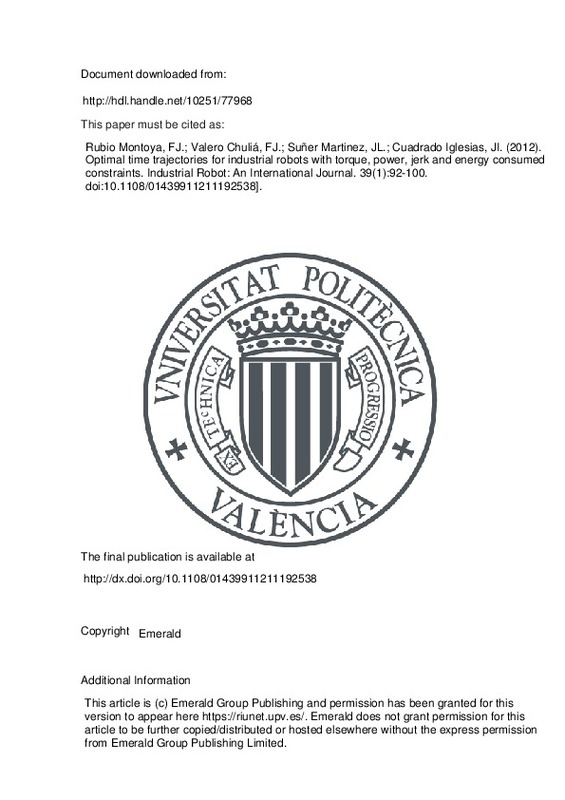JavaScript is disabled for your browser. Some features of this site may not work without it.
Buscar en RiuNet
Listar
Mi cuenta
Estadísticas
Ayuda RiuNet
Admin. UPV
Optimal time trajectories for industrial robots with torque, power, jerk and energy consumed constraints
Mostrar el registro sencillo del ítem
Ficheros en el ítem
| dc.contributor.author | Rubio Montoya, Francisco José
|
es_ES |
| dc.contributor.author | Valero Chuliá, Francisco José
|
es_ES |
| dc.contributor.author | Suñer Martinez, Josep Lluis
|
es_ES |
| dc.contributor.author | Cuadrado Iglesias, Juan Ignacio
|
es_ES |
| dc.date.accessioned | 2017-02-16T17:04:33Z | |
| dc.date.available | 2017-02-16T17:04:33Z | |
| dc.date.issued | 2012 | |
| dc.identifier.issn | 0143-991X | |
| dc.identifier.uri | http://hdl.handle.net/10251/77968 | |
| dc.description | This article is (c) Emerald Group Publishing and permission has been granted for this version to appear here https://riunet.upv.es/. Emerald does not grant permission for this article to be further copied/distributed or hosted elsewhere without the express permission from Emerald Group Publishing Limited. | es_ES |
| dc.description.abstract | [EN] Purpose - The purpose of this paper is to analyze the impact of the torque, power, jerk and energy consumed constraints on the generation of minimum time collision-free trajectories for industrial robots in a complex environment. Design/methodology/approach - An algorithm is presented in which the trajectory is generated under real working constraints (specifically torque, power, jerk and energy consumed). It also takes into account the presence of obstacles (to avoid collisions) and the dynamics of the robotic system. The method solves an optimization problem to find the minimum time trajectory to perform the tasks the robot should do. Findings - Important conclusions have been reached when solving the trajectory planning problem related to the value of the torque, power, jerk and energy consumed and the relationship between them, therefore enabling the user to choose the most efficient way of working depending on which parameter he is most interested in optimizing. From the examples solved the authors have found the relationship between the maximum and minimum values of the parameters studied. Research limitations/implications - This new approach tries to model the real behaviour of the actuators in order to be able to upgrade the trajectory quality, so a lot of work has to be done in this field. Practical implications - The algorithm solves the trajectory planning problem for any industrial robot and the real characteristics of the actuators are taken into account, which is essential to improve the performance of it. Originality/value - This new tool enables the performance of the robot to be improved by combining adequately the values of the mentioned parameters (torque, power, jerk and consumed energy). | es_ES |
| dc.description.sponsorship | This paper has been made possible thanks to support from the Spanish Ministry of Science and Innovation, through the Project for Research and Technological Development, ref. DPI2010-20 814-C02-01. | |
| dc.language | Inglés | es_ES |
| dc.publisher | Emerald | es_ES |
| dc.relation.ispartof | Industrial Robot: An International Journal | es_ES |
| dc.rights | Reserva de todos los derechos | es_ES |
| dc.subject | Dynamics constraints | es_ES |
| dc.subject | Energy consumption | es_ES |
| dc.subject | Industrial robots | es_ES |
| dc.subject | Robots | es_ES |
| dc.subject | Torque | es_ES |
| dc.subject | Trajectories | es_ES |
| dc.subject | Trajectory planning | es_ES |
| dc.subject | Optimal time | es_ES |
| dc.subject.classification | INGENIERIA MECANICA | es_ES |
| dc.title | Optimal time trajectories for industrial robots with torque, power, jerk and energy consumed constraints | es_ES |
| dc.type | Artículo | es_ES |
| dc.identifier.doi | 10.1108/01439911211192538] | |
| dc.relation.projectID | info:eu-repo/grantAgreement/MICINN//DPI2010-20814-C02-01/ES/IDENTIFICACION DE PARAMETROS DINAMICOS EN VEHICULOS LIGEROS Y ROBOTS MOVILES. APLICACION A LA IDENTIFICACION EN TIEMPO REAL/ | es_ES |
| dc.rights.accessRights | Abierto | es_ES |
| dc.contributor.affiliation | Universitat Politècnica de València. Departamento de Ingeniería Mecánica y de Materiales - Departament d'Enginyeria Mecànica i de Materials | es_ES |
| dc.contributor.affiliation | Universitat Politècnica de València. Escuela Técnica Superior de Ingenieros Industriales - Escola Tècnica Superior d'Enginyers Industrials | es_ES |
| dc.contributor.affiliation | Universitat Politècnica de València. Escuela Técnica Superior de Ingeniería del Diseño - Escola Tècnica Superior d'Enginyeria del Disseny | es_ES |
| dc.description.bibliographicCitation | Rubio Montoya, FJ.; Valero Chuliá, FJ.; Suñer Martinez, JL.; Cuadrado Iglesias, JI. (2012). Optimal time trajectories for industrial robots with torque, power, jerk and energy consumed constraints. Industrial Robot: An International Journal. 39(1):92-100. https://doi.org/10.1108/01439911211192538] | es_ES |
| dc.description.accrualMethod | S | es_ES |
| dc.relation.publisherversion | http://dx.doi.org/10.1108/01439911211192538 | es_ES |
| dc.description.upvformatpinicio | 92 | es_ES |
| dc.description.upvformatpfin | 100 | es_ES |
| dc.type.version | info:eu-repo/semantics/publishedVersion | es_ES |
| dc.description.volume | 39 | es_ES |
| dc.description.issue | 1 | es_ES |
| dc.relation.senia | 209050 | es_ES |
| dc.identifier.eissn | 1758-5791 | |
| dc.contributor.funder | Ministerio de Ciencia e Innovación |







![[Cerrado]](/themes/UPV/images/candado.png)

